Share now
Map of Sindh
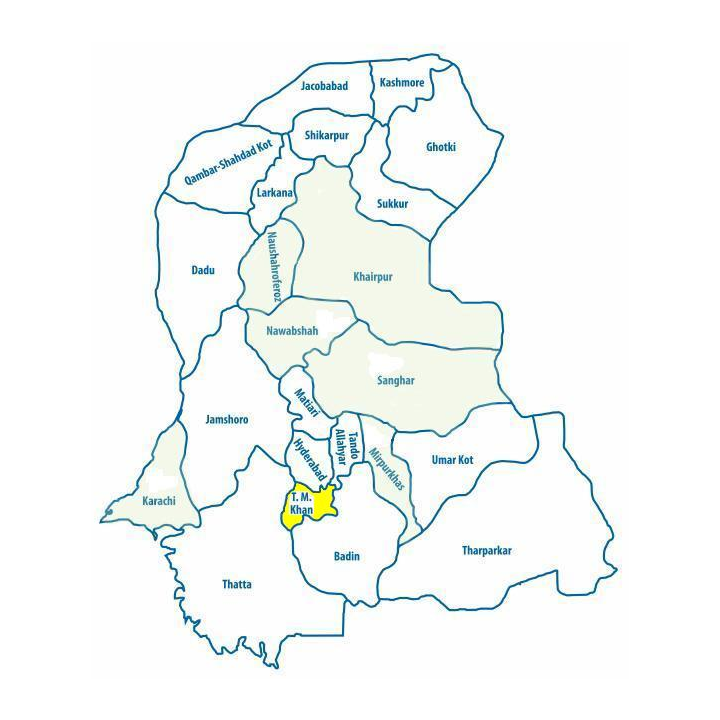
Map of Tando Muhammad Khan District
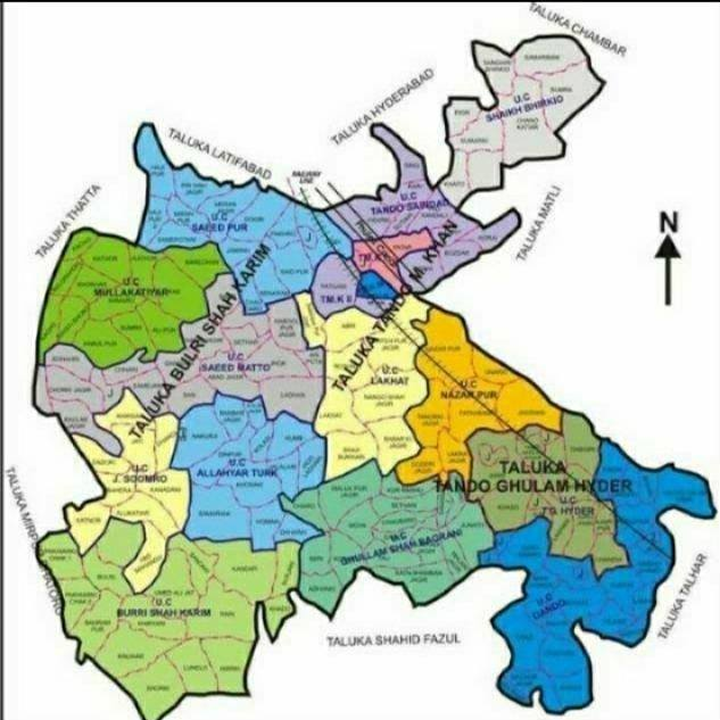
Sindh Districts
- Karachi District Profile
- Badin District Profile
- Dadu District Profile
- Ghotki District Profile
- Hyderabad District Profile
- Jacobabad District Profile
- Jamshoro District Profile
- Kashmore District Profile
- Khairpur District Profile
- Larkana District Profile
- Matiari District Profile
- Mirpurkhas District Profile
- Naushero FerozeDistrict Profile
- Sanghar District Profile
- Shahdadkot District Profile
- Shaheed Benazirabad District Profile
- Shikarpur District Profile
- Sukkhur District Profile
- Tando AllahYar District Profile
- Tando Mohammad Khan District Profile
- Tharparkar District Profile
- Thatta-Sajawal District Profile
- Umerkot District Profile
Also visit: Punjab, Balochistan, Khyber Pakhtunkhwa
Tando Muhammad Khan District Profile
Introduction/Geographical Location; Tando Muhammad Khan district
District Tando Mohammad Khan (TMK) is located between 68° 15Ꞌ 14” to 68° 44Ꞌ 2” East longitudes and 24° 45Ꞌ 41” to 25° 17Ꞌ 8” North latitudes, and is situated at a distance of 35 km from Hyderabad. It is bordered by Hyderabad and Tando Allahyar districts to the North, Badin district to the South and East, and Thatta district to the West. River Indus flows in the Northwest.
Tando Muhammad Khan District at a Glance
| Name of District | Tando Mohammad Khan District | ||
| District Headquarter | Tando Mohammad Khan Town | ||
| Population[1] | 677,000 persons | ||
| Area[2] | 1,555 km2 | ||
| Population Density | 435.4 persons/ km2 | ||
| Population Growth Rate[3] | 2.3% | ||
| Male Population[4] | 51.7% | ||
| Female Population[5] | 48.3% | ||
| Urban Population[6] | 21% | ||
| Tehsils |
3 Tehsils: 1. Tando Mohammad Khan 2. Tando Ghulam Haider 3. Bulri Shah Karim |
||
| Main Towns | Tando Mohammad Khan, Bulri Shah Karim, Tando Ghulam Haider, Sheikh Bhirkio, Dando, Nizamani, Mullan Katiar, Tando Saindad, Lakhat, Nazarpur, Ghulam Shah Bhagrani, Moya, Allahyar Turk, Janhan Soomro, Saeedpur, and Saeed Mato | ||
| Literacy Rate[7] | 30% | ||
| Male Literacy Rate[8] | 39% | ||
| Female Literacy Rate[9] | 21% | ||
| Economic Activity[10] | Agriculture, Forestry, Fishing & Hunting[11] | 47.9% | |
| Construction | 14.5% | ||
| Wholesale, Retail, Hotels/Restaurants | 18.8% | ||
| Community, Social & Personal Services | 18.8% | ||
| Main Crops | Cotton, rice, sugarcane, jowar, bajra, maize, wheat, barley, gram, rapeseed and mustard, moong, masoor, arhar, and maash | ||
| Major Fruits | Bananas, chikoo, guava, jaamun, mango, musk melon, papaya, citrus, ber, and mulberry | ||
| Major Vegetables | Onions, potatoes, peas, okra, tinda, brinjal, bitter gourd, bottle gourd, pumpkin, melon pumpkin, luffa, cucumber, long melon, purslane, beans, field vetch, arum, lotus roots, turnip, carrots, spinach, tomatoes, cauliflower, cabbage, sweet potatoes, radish, garden peas, fenugreek, lettuce, chilies, garlic, coriander, ajwain, and fennel | ||
| Forests (Area)[12] | 627 HA[13] | ||
| Total Metalled Road[14] | 408 km | ||
| Shingle Roads[15] | – | ||
| No Of Grid Stations[16] | 02 grid stations, each with capacity of 132 KV | ||
| No. of Tel. Exchanges | Telephone connections are available | ||
| Industrial Zones[17] | There is no Industrial Estate in the district, and industries are scattered. There are 132 units in total, of which 80 are handicraft units for the production of Ajrak | ||
| Major Industry[18] | Flour Mills | 18 Units | |
| Sugar Mills | 05 Units | ||
| Ice Factories | 08 Units | ||
| Ajrak | 80 Units | ||
| Rice Mills | 20 Units | ||
| Cotton Ginning | 01 Unit | ||
| Household Size[19] | 6.5 persons | ||
| Houses (Piped Water Inside)[20] | 20.7%[21] | ||
| Houses with Electricity[22] | 56.6%[23] | ||
Table 1.1 Tando Muhammad Khan (TMK) District at a Glance
[1] 2017 Census.
[2] Hyderabad District Census; 1998, TMK Taluka
[3] 2017 Census
[4] 2017 Census
[5] 2017 Census
[6] 2017 Census
[7] Pakistan Social & Living Measurement 2014-15 (PSLM); latest available
[8] PSLM
[9] PSLM
[10] Hyderabad District Census Report, 1998, TMK Taluka; 2017 Census Data has not been made public yet.
[11] Hyderabad District Statistics; 2017 Census Data has not been made public yet.
[12] Sindh Development Statistics, 2012-13
[13] Forestry Statistics; Land Utilization Statistics reports forest area at nil
[14] Sindh Development Statistics, 2017-18
[15] Sindh Development Statistics, 2017-18
[16] Environmental & Social Assessment for HESCO, by Elan Partners 2007, latest available
[17] A Profile of TMK, by USAID (Pakistan Emergency Situation Analysis) September 2014
[18] A Profile of TMK
[19] Hyderabad District Census 1998, TMK Taluka; 2017 Census Data has not been made public yet.
[20] 1998 Census; 2017 Census Data has not been made public yet.
[21] Hyderabad District Statistics; 2017 Census Data has not been made public yet.
[22] 1998 Census; 2017 Census Data has not been made public yet.
[23] Hyderabad District Statistics, 2017 Census Data has not been made public yet.
Brief History of Tando Muhammad Khan district
The district was part of Hyderabad district till 2005, when the existing tehsil—Tando Muhammad Khan—was designated as a district by the Chief Minister of Sindh, Mr. Arbab Ghulam Rahim. The history of the district, thus, is the same as the history of Hyderabad, and has been recounted in the relevant chapter.
- W. Huges, in the Sindh Province Gazetteer, shows that
The town of Tando Muhammad Khan was founded about eight years after commencement of Mir Fateh Ali Khan’s rule [1783] by Mir Muhammad Khan Talpur Shahwani. Soon after this event the lands around the town came into his possession as “Jagir.” Mir Muhammad Khan died in 1813 and was succeeded by his son Mir Karam Khan, and he again by Mir Ghulam Shah, who was killed in the battle about the time British took Sindh (1843). (p. 836)
The town became a municipality in 1856. Before the British conquest of Sindh, the town of Tando Muhammad Khan was made the headquarters/ capital of Guni Taluka, once it was founded and developed by Mir Muhammad Khan Talpur. Mir Ghulam Ali Khan Talpur (1909-1963) continued to develop the town’s infrastructure, and not only did he establish educational institutions for the provision of quality education, he also personally helped provide social services in the area. His grave is in Tando Muhammad Khan.
The name and boundary of Guni Taluka remained untouched till 1955 when the Bill for One Unit Policy was passed by the Pakistan National Assembly. This bill merged the four provinces and all districts of West Pakistan into one province which was called West Pakistan, with its capital at Lahore. In 1970, the province of West Pakistan was dissolved by the President and Chief Martial Law Administrator, Yahya Khan, and four new provinces were created, along with some changes in Pakistani Kashmir. At the time of the restoration of Sindh province, the name of Guni Taluka was changed to Tando Muhammad Khan Taluka because the town Tando Mohammad Khan was the headquarters.
Governmental Structure;Tando Muhammad Khan district
At the Federal level, Tando Muhammad Khan district is allocated a set number of representatives in both the National Assembly and the Provincial Assembly:
- Number of seats in the National Assembly 2
- Number of seats in the Provincial Assembly 2
The district has one Municipal Committee:
- Tando Muhammad Khan
It has 2 Town Committees:
- Bulri Shah Karim
- Tando Ghulam Hyder
Administrative Divisions;Tando Muhammad Khan district
There are 3 Talukas of Tando Muhammad Khan district as follows:
| Tando Muhammad Khan | 6 Union Councils |
| Tando Ghulan Haider | 4 Union Councils |
| Bulri Shah Karim | 6 Union Councils |
Table 1.2 TMK Administrative Divisions
Heritage Buildings/Recreational Areas;Tando Muhammad Khan district
A Buddhist Stupa (Guja) or Sudheranjo-Dar, located a few miles from Tando Muhammad Khan Town is a Protected Heritage Area under the Government of Pakistan’s laws. A square plan of the plinth, or the heavy base of the stupa, as well as the steep hard core of the superstructure have survived. The curved bricks used in the structure help date it to the Gupta era.
Topography; Tando Muhammad Khan District (TMK)
Tando Muhammad Khan district is part of the lower Indus plain formed by the alluvial deposits of the Indus River. The district is situated at the foot of Ganjo Takkar Hills Range that runs nearly due South, parallel to the Indus for about 22.5 km (14 miles). The hills have an elevation of just 31 meters (100 feet). Fuller’s earth[1] is mined in these hills. There are 2 small hillocks on the North of Tando Muhammad Khan town, called Budhaka Takkar. The rest of the district is fertile plain with an elevation of about 11 meters above sea level.
Rivers, Streams, and Lakes; Tando Muhammad Khan District (TMK)
The River Indus flows through the district, in the Northwest. There are a few intermittent streams that flow during rainy season; these[2] include Dhadhko Wah, Mulchand Wah, Sapa Wah, and Mir Wah. There are a few small dhands/ lakes in the district. These include Chhari dhand, and Kulab lake/dhand.
Forests; Tando Muhammad Khan District (TMK)
Tando Muhammad Khan district is a forest deficient area. Total forest cover in the district was 620 HA up until 2011. There were 2 important forests, the Mula Katiar Reserved Forest (381 HA) and the Budhka Reserved Forest (598 HA). These forests have since been encroached upon, and converted into agricultural land.
Soils; Tando Muhammad Khan District (TMK)
The soils of the district mainly consist of loamy and clayey soils of older river plains and are very fertile.
Climate; Tando Muhammad Khan District (TMK)
The climate of Tando Mohammad Khan district is moderate. However, the summer months—April, May, and June—are very hot during the day. The mean minimum and maximum temperatures during this period are 25 °C and 45 °C respectively. December and January are the coldest months, with maximum and minimum temperatures of 30 °C and 10 °C respectively. The temperature falls abruptly at night. The climate is tempered by the West and South winds, which blow for 8 months, from March to October, making the hot weather tolerable. The autumn season starts in September and lasts for about 2 months. The maximum recorded humidity at Tando Mohammad Khan is 55%. Rainfall is highly erratic, with an annual average of 130 mm. The Monsoon dominates from July to September.
Seismic Activity/Seismicity; Tando Muhammad Khan District (TMK)
The district falls under Zone 2 A of the Pakistan Seismic Zone Map which means that there will be moderate to low damage by earthquakes.
[1] Imperial Gazetteer of India, v.13 p.317
[2] From travelingluck.com
Population; Tando Muhammad Khan District (TMK)
The following table shows the population figures for the district as per the 2017 census:
| District/Taluka |
Area km2 |
Population | Male% | Female% | Urban % | Growth Rate % |
| TMK District | 1,554 | 677,228 | 51.7 | 48.3 | 21 | 2.3 |
| TMK Taluka | 311 | 255,662 | ||||
| Bulri Shah Karim | 770 | 236,913 | ||||
| Tando Ghulam Haider | 490 | 184,653 |
Table 1.3 TMK Population Statistics
Religions; TMK district[1]
| Muslims | 80.9% |
| Christians | 0.3% |
| Hindus | 17.6% |
| Qadianis | 0.1% |
| Scheduled Castes | 0.9% |
| Others | 0.1% |
Table 1.4 TMK Religions
Languages; TMK District[2]
| Urdu | 2.8% |
| Punjabi | 2.3% |
| Sindhi | 91.5% |
| Pushto | 0.9% |
| Balochi | 0.1% |
| Seraiki | 0.7% |
| Others[3] | 2.3% |
Table 1.5 TMK Languages
[1] 1998 Census; 2017 Census Data has not been made public yet.
[2] 1998 Census; 2017 Census Data has not been made public yet.
[3] This includes Brahvi also
Economic Activity – Economic Infrastructure
Economic Activity; Tando Muhammad Khan District
The major economic activities[1] of the district are:
- Agriculture, Forestry, Fishing & Hunting (47.9%)
- Construction (14.5%)
- Wholesale, Retail, Hotels/Restaurants (18.8%)
- Community, Social & Personal Services (18.8%)
Land Use; Tando Muhammad Khan District
The following table shows the main land use statistics of the district as per Sindh Development Statistics 2017-18:
| Land Use | Area | Land Use | Area |
| Total Area | 195,000 HA | Reported Area | 195,000 HA |
| Cultivated Area | 144,000 HA | Current Fallows | 94,000 HA |
| Net Area Sown | 50,000 HA | Culturable Waste | 24,000 HA |
| Forest Area | – HA |
Table 1.6 TMK Land Use Statistics
Irrigation Network; Tando Muhammad Khan District
Tando Muhammad Khan district is irrigated by canals off-taking from Sukkur and Kotri Barrages. The Phulleli canal, Akram Wah, Pinyari Canal and Guni Wah are the main canals supplying water for irrigation as well as for domestic and other uses. In addition, there are 296 wells and tube wells in the district. The following table shows the mode of irrigation and area irrigated by each mode as per Sindh Development Statistics 2017-18:
| Mode of Irrigation | Area | Mode of Irrigation | Area |
| Irrigated Area | 30,780 HA | Un-Irrigated Area | 19,223 HA |
| Canal Irrigated | 21,132 HA | Well Irrigated | – HA |
| Tube Well Irrigated | 9,648 HA |
Table 1.10 TMK Irrigation Statistics
Agriculture; Tando Muhammad Khan District
Nearly 70% of the rural population of the district is employed in agriculture and its allied livestock breeding as its main occupation. Main crops are cotton, rice, sugarcane, jowar, bajra, maize, wheat, barley, gram, rapeseed & mustard, moong, masoor, arhar, and maash.
The vegetables produced in the district are onions, peas, okra, tinda, brinjal, bitter gourd, bottle gourd, pumpkin, melon pumpkin, luffa, cucumber, long melon, purslane, beans, field vetch, arum, lotus roots, turnip, carrots, spinach, tomatoes, cauliflower, cabbage, sweet potatoes, radish, garden peas, fenugreek, lettuce, chilies, garlic, coriander, ajwain, and fennel.
The fruits produced in the district are bananas, chikoo, guava, jaamun, mango, musk melon, papaya, citrus, ber, and mulberry.
Livestock Breeding; Tando Muhammad Khan District
Livestock breeding contributes roughly one-third to the total share of agricultural production.
There is a large Red Sindhi cattle breeding farm in the district, which is managed by the Animal Husbandry Department of the Government of Sindh. Red Sindhi cattle is indigenous to the North and northwestern parts of Karachi and Hyderabad, including Kohistan area (Sindh province) and Lasbella district in Baluchistan province.
Red Sindhi cow, cross-breed cattle, kundi buffalo, kamori goat, barbary goat, and thorough bred horses are native breeds of the district, as they are of Sindh. The following table shows the livestock statistics[2] for the district:
| Cattle | 57,000 Heads | Buffaloes | 158,000 Heads | Sheep | 24,000 Heads |
| Goats | 136,000 Heads | Camels | 2,000 Heads | Asses | 8,000 Heads |
| Horses | – Heads | Mules | – Heads |
Table 1.7 TMK Livestock Statistics
Poultry Farms; Tando Muhammad Khan District
Most farmers keep a few head of poultry for their eggs and meat. Most of the poultry farms are located in the urban areas of the district. There are 159 poultry farms[3] in the district.
Fishing; Tando Muhammad Khan District
Inland fishing is carried out in River Indus and the water canals of Tando Muhammad Khan district. A large number of both full-time and part-time fishermen engage in this activity in the district.
Bee Keeping/Api Culture; Tando Muhammad Khan District
Honey-bee keeping was introduced in Pakistan in the 1980s, when IUCN and UNDP introduced apiculture in the coastal villages of Sindh, especially in Badin and Thatta. This project aims to protect the mangroves of the districts.
Minerals and Mining; Tando Muhammad Khan District
The district has 110 oil and gas wells which are producing oil and gas for the country. Coal has been discovered near Bulri Shah Karim Taluka and Mullakatiar Union Council. Fuller’s earth, limestone, and alum are also mined in the district.
Industry and Manufacture; Tando Muhammad Khan District
Tando Muhammad Khan is primarily an agro-based district and thus, its industrial base is dependent on its agricultural production. This district has established industries, the raw material for which is provided by the agriculture sector. Tando Mohammad Khan is the second largest producer of Ajrak (a special Sindhi hand block-printed fabric mostly used as a shawl) in Pakistan and a small scale Ajrak manufacturing industry is well-established in this district. Sugar mills, flour mills, and rice mills as well as factories producing detergents are also operating in this district.
The following table shows the major industries and number of units[4] located in various areas of the district:
| Flour Mills, | 18 Units |
| Sugar Mills, | 5 Units |
| Rice Mills, | 20 Units |
| Ice Factories, | 8 Units |
| Cotton Ginning | 1 Unit |
| Ajrak | 80 Units |
Table 1.8 TMK Industrial Units
According to the official website of National Vocational & Technical Training Commission there are 2 sugar mills, 1 polymer packaging mill, 1 Distillery, and 1 cotton ginning mill in the industry[5].
Handicrafts; Tando Muhammad Khan District
The district offers unique handicrafts such as handmade carpets, and Ajraks. In addition to being the second largest producer of Ajraks, Tando Muhammad Khan is a leading producer of Soosi cotton cloth. Mats, baskets, and other crafts made of reeds and bamboo, clay, terracotta, and ceramics work are also produced in the district.
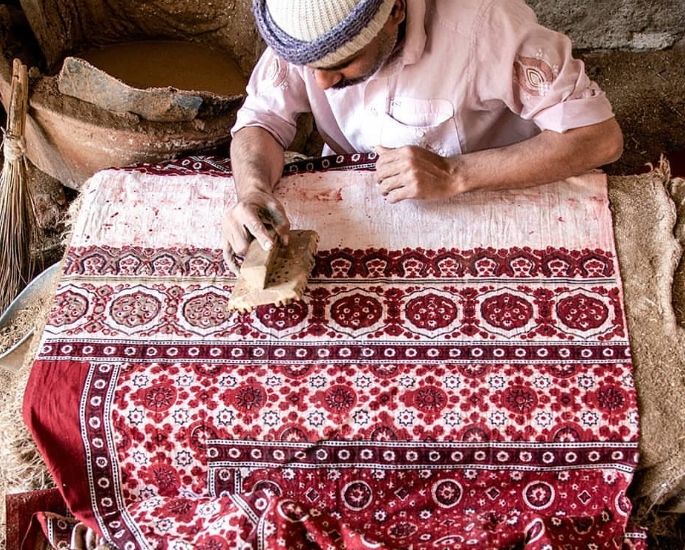
Figure 1.3 Ajrak Making in TMK district
Economic Infrastructure; Tando Muhammad Khan District
Roads link Tando Muhammad Khan district with its Taluka headquarters and other parts of the country, and are the most important mode of communication. The district is linked with other parts of Pakistan via railway.
Road Statistics; Tando Muhammad Khan District
The road list issued by Sindh Government in 2009 does not contain data about the roads in Tando Mohammad Khan district, but the Sindh Development Statistics 2017-18 reports the statistics of the roads in the district as follows:
| High Type Roads | 408 km |
| Low Type Roads | – km |
Table 1.9 TMK Road Statistics
Some of the important roads of the district are:
- Tando Muhammad Khan‒Mirpur Bathelo Road
- Hyderabad‒Badin Road
- Tando Allahyar‒Tando Muhammad Khan Road
- Tando Muhammad Khan‒Matli Road
- Roads to Tando Allahyar, Matli, Bulri, and Sujawal
Railways and Airways; Tando Muhammad Khan District
The district is linked with Hyderabad and Karachi through a railway line. There is a railway station at Tando Muhammad Khan town, called Tando Muhammad Khan Railway Station.
Radio and Television; Tando Muhammad Khan District
TV can be viewed through boosters and cable, and there is a radio channel called Indus FM in the district.
Telecommunications; Tando Muhammad Khan District
Internet is available in all Talukas of the district. Telephone connections are also available; there are 3,181 telephone connections[1] in the district. There are 139 public call offices and nearly all the major cellular companies operate in the district.
Post Offices/ Courier Services; Tando Muhammad Khan District
Hyderabad GPO is responsible for distributing mail in Tando Muhammad Khan district. There is a main post office in each Taluka of the district and branch offices in other areas.
Banking/ Financial Institutions; Tando Muhammad Khan District
Banks that have their branches in the district include[2]:
- National Bank of Pakistan
- United Bank Ltd.
- Habib Bank Ltd.
- Allied Bank Ltd.
- Zarai Taraqiati Bank Ltd.
In all there are 18 branches of conventional banks and 1 branch of Islamic bank in the District.
Electricity and Gas; Tando Muhammad Khan District
Tando Muhammad Khan district gets its electricity through the grid stations and transmission lines provided by Hyderabad Electricity Supply Corporation which is a subsidiary of WAPDA and is responsible for supplying electricity. There are 2 grid stations in the district each with capacity of 132 KV.
Educational Institutions; Tando Muhammad Khan District
The following table shows the number of educational institutions in the district as per Sindh Development Statistics 2017-18:
| Institution | Boys/Girls | Institution | Boys/Girls |
| Primary Schools | 841/97 | Middle Schools | 27/07 |
| High Schools | 28/12 | Higher Secondary Schools | -/- |
| Colleges | 01/01 | Technical Institutions | 01/- |
| Commercial Training | -/- | Vocational Training | -/01 |
| Medical Colleges[3] | 01 | Engineering Colleges | – |
Table 1.11 TMK Education Institutes
In addition, there are nearly 21 private schools and 4 private colleges[4] in Tando Muhammad Khan district.
Healthcare Facilities; Tando Muhammad Khan District
The following table shows the Government Health Care Institutions in Tando Muhammad Khan district as per Health Profile Sindh District 2017-18:
| Institution | No./Beds | Institution | No./Beds |
| Government Hospitals | 01/30 | Dispensaries | 06/- |
| Rural Health Centers | 03/34 | Basic Health Units | 15/32 |
| T B Clinics | 03/- | Mother Child Health Centers | -/- |
| Private Hospitals | 03/100 | Private TB Clinics | -/- |
| Private Dispensaries | 11/- | Private MCHC | 01/- |
Table 1.12 TMK Health Care Institutes
In addition, there is a Unani Shifa Khana[5] in the district.
Policing; Tando Muhammad Khan District
The Provincial Police Officer (PPO) Sindh is responsible for policing the entire province of Sindh. This PPO is assisted by 6 Additional Inspector General (AIG) Police. The AIG Police Hyderabad Division is in charge of Hyderabad, Tando Muhammad Khan, Matiari, Tando Allahyar, Badin, and Nawabshah districts. The District Police Officer Tando Muhammad Khan is responsible for policing of the district. There are 3 police stations[6] in the main towns of the district.

Figure 1.4 A Mosque near Tando Muhammad Khan

Figure 1.5 A Monument in Mir Ghulam Ali Talpur Public Park
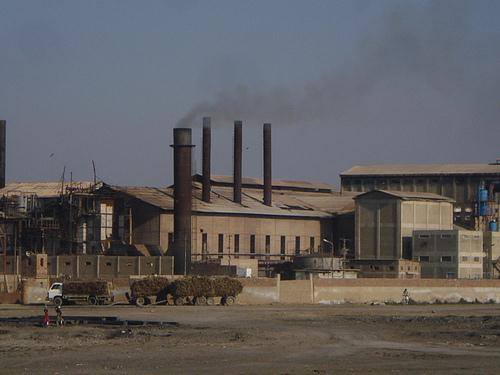
Figure 1.6 TMK Sugar Mill
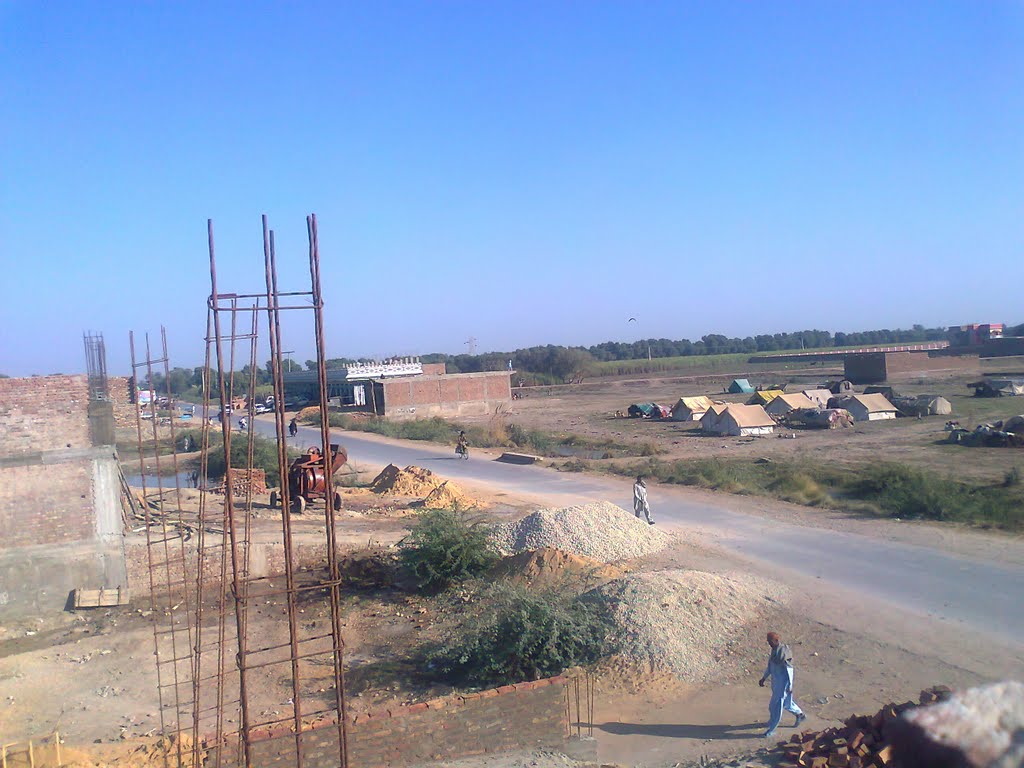
Figure 1.7 TMK‒Matli Road
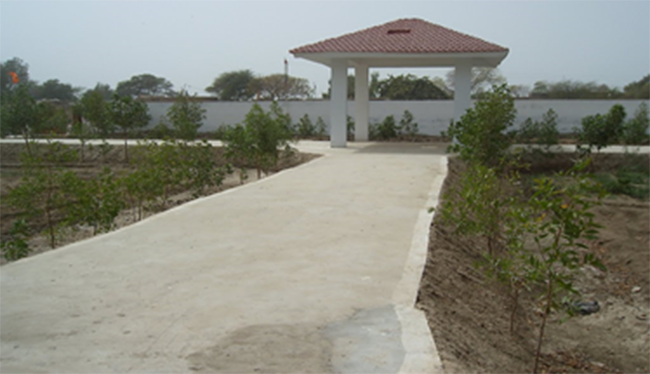
Figure 1.8 Shiv Mandir TMK
[1] Data retrieved from TMK District Government official website.
[2] List of Reporting Bank Branches 2019, State Bank of Pakistan.
[3] Indus Medical College (Privately owned)
[4] TMK District Government Site
[5] Herbal Medicines are used for treatment.
[6] Tando Muhammad khan District Development Profile by District Government of TM Khan
[1] This includes data for Tando Allahyar, Matiari, and Tando M Khan Districts also, from 1998 Census; 2017 Census Data has not been made public yet.
[2] 2006 Livestock Census as recorded in Sindh Development Statistics 2017-18
[3] Table 17 Number of Commercial Poultry Farms and Number of Birds by Size of Flock
[4] A Profile of TMK by USAID (Pakistan Emergency Situation Analysis) Feb. 2013
[5] http://www.skillingpakistan.org/employer/province/9/district/64 retrieved July 2010.
Environment and Biodiversity; Tando Muhammad Khan District
Tando Muhammad Khan is an agro-industrial district. In urban areas, ambient air quality, supply of contaminated water, unsafe disposal of municipal waste and solid waste, unsafe disposal of infectious hospital waste, and congested houses have created severe environmental degradation.
Flora and Fauna; Tando Muhammad Khan District
The district belongs to the Irrigated Agro-Ecological Zone of Pakistan. The type of soil (sandy, loamy, water logged or saline), and the amount of moisture available mainly governs the vegetation species. Mostly, both sides of the roads are covered with thick vegetation which fulfills its water requirements from the seepage of farmlands, agricultural fields, and canals of the irrigation water network. Sweet water is available in the ground, which supports a large variety of vegetation.
Flora
The flora of the district includes[1] babul or gum Arabica (Acacia nilotica), Indian walnut or white sirin (Albizia procera), neem or ash-leaved bead tree (Azadirachta indica), amaltas or pudding pipe tree (Cassia fistula), Ethiopian teak or kono (Conocarpus lancifolius), shisham or tale (Dalbergia sisso), red gum or sufaida (Eucalyptus camaldulensis), Indian fig or banyan (Ficus benghalensis), jungle jalebi (Pithecellobium dulce), silk cotton tree or simal (Salmalia malabarica), Egyptian pea or jantar/jinjerh (Sesbania aegyptiaca), arjuna or white marudah (Terminalia arjuna), tulip tree or parus peepal (Thespesia populnea), kandi or jand (Prosopis spicegera), devi or mesquite (Prosopis glandulosa), karir or capparis (Capparis aphylla), ber (Zizyphus mauritiana), kikri or baveri (Acacia jacquemontii), khabar or peelu/ toothbrush tree (Salvadora oleoides), athel pine or frash (Tamarix aphylla), lai or salt cedar (Tamarix dioica), desert tamarisk (Tamarix articulate), and gum Arabic (Acacia senegal).
Shrubs and herbs of the district include phog (Calligonum palygonides), buh or kapok bush (Aerva tomentosa), munj or wild sugarcane (Saccahrum spontaneum), kanderi or katel/thorny nightshade (Solanum xanthocarpum) and kandero or camel thorn (Alhagi maurorum).
Various grasses growing in the district are gum or desert bunch grass (Panicum antidotate), khavi or jawarancusa grass (Chrysopogon jawarancusa), and dhub or halfa grass (Desmostachya bipinnata).
Ornamental flowers found in farms, gardens and elsewhere in the area are rose (Rosa damascena), jasmine (Jasminum officinale), and tuberose (Polianthes tuberose).
Fauna
Separate data for fauna of Tando Muhammad Khan is not available. At present, since there are no forests, and due to high population growth rate, the wildlife of the district is nearly non-existent. Jackals and foxes are seen in the dry rangelands. Birds of the area include black and grey partridges, buft-backed heron, Indian reef heron, Mongolian sand plover, little brown dove, cuckoo, Indian scoops owl, and Indian great-horned owl. Reptilian fauna includes Indian monitor, agama and garden lizard, cobra, and viper.
Protected Areas ; Tando Muhammad Khan District
There are no wildlife protected areas in the district.
Picnic Spots/ Recreational Areas; Tando Muhammad Khan District
Following are some areas of interest[2] in the Tando Muhammad Khan district:
- Shrine of Hazrat Shah Abdul Karim Bulri Waro
- Shahjehan Mosque, Sehrani, Taluka Bulri Shah Karim
- Sudhorol Jo Thul near Mulla Katiyar, Taluka Bulri Shah Karim
- Mir Ghulam Ali Khan Talpur Municipal Park, Tando Muhammad Khan
- Shaheed Benazir Bhutto Park, Tando Muhammad Khan
- Dhandi Mosque, UC Janhan Soomro
- Grave of Sheikh Mamo, UC Janhan Soomro
- Maqbara Mir Muhammad Khan
- Birthplace of Birbal, Tando Ghulam Hyder
- Red Sindhi Cattle Farm, Tando Muhammad Khan
- Nukerji Farm, Deenpur, Tando Muhammad Khan
- Ganjo Takkar Hill, Saeed Pur, Tando Muhammad Khan
- Hanuman Mandir and Shiv Mandir, Tando Muhammad Khan
- Mir Ghulam Ali Talpur Public Park, Tando Muhammad Khan
- Shah Latif Public Park
- Aslam Park
Shrines/ Dargahs in Tando Muhammad Khan[3]
- Dargah Sheikh Bhrakio Achari, UC Sheikh Bhrakio
- Dargah Mian Muhammad Ishaque Mullakatiar, Taluka Bulri Shah Karim
- Dargah Shah Abdul Fatah Shah, Taluka Tando Muhammad Khan
- Dargah Hyder Shah Bukhari, UC Lakhat, Tando Muhammad Khan Taluka
- Dargah Dullah Shah, Jural Shah, Tando Muhammad Khan
- Dargah Subhago Faqeer at Behrani Muhalla, Tando Muhammad Khan
- Dargah Sheikh Fareed at UC Lakhat, Tando Muhammad Khan
- Dargah Burhan Shah, Taluka Tando Muhammad Khan
- Dargah Jeya Shah, UC Saeed Matto, Bulri Shah Karim
- Dargah Paryal Shah, UC Saeed Matto, Bulri Shah Karim
- Dargah Noh Sarwar, Tando Ghulam Hyder
- Dargah Jumman Shah, Taluka Tando Muhammad Khan
- Dargah Malook Shah, Tando Muhammad Khan Taluka
- Dargah Sain Ibrahim Shah, Tando Muhammad Khan Taluka
[1] Environmental Assessment/ Environmental Management Plan for Sindh Irrigated Agriculture Productivity Enhancement Project (SIAPEP), by M/S Country Survey & Mapping Services and Fincon Services Inc.
[2] Development Profile TMK District by TMK Government
[3] Development Profile TMK District by TMK Government
